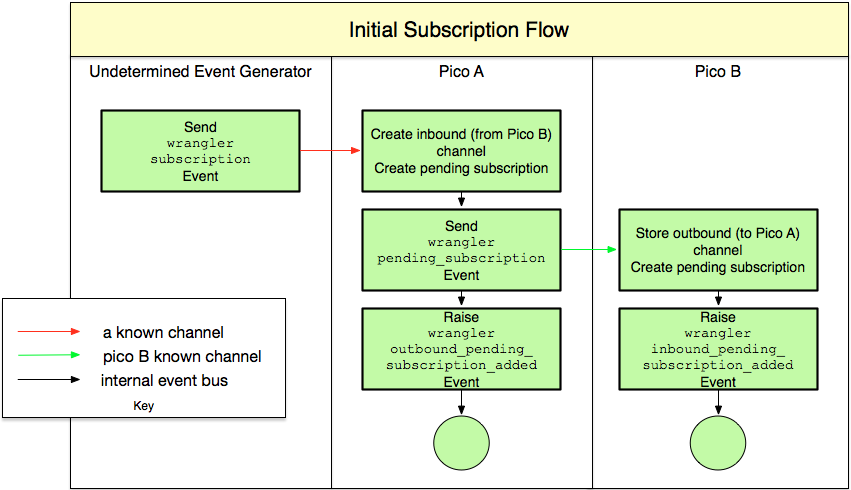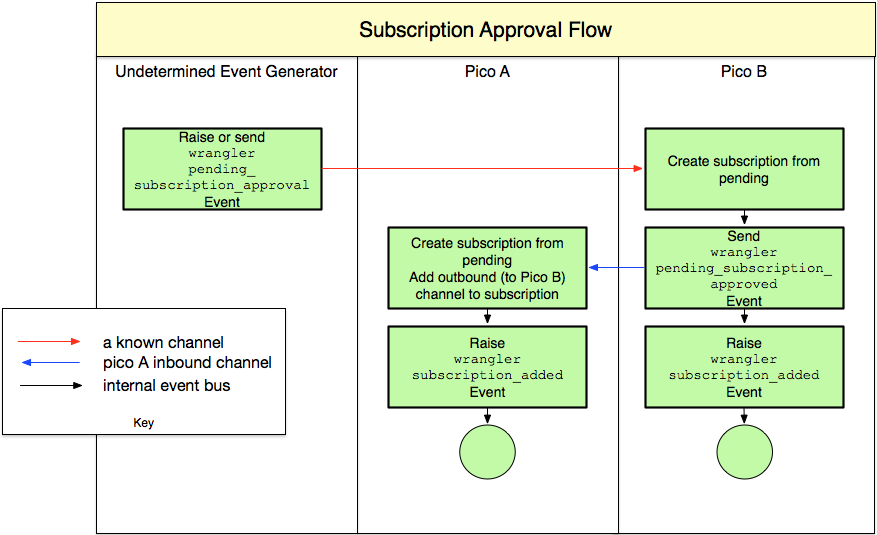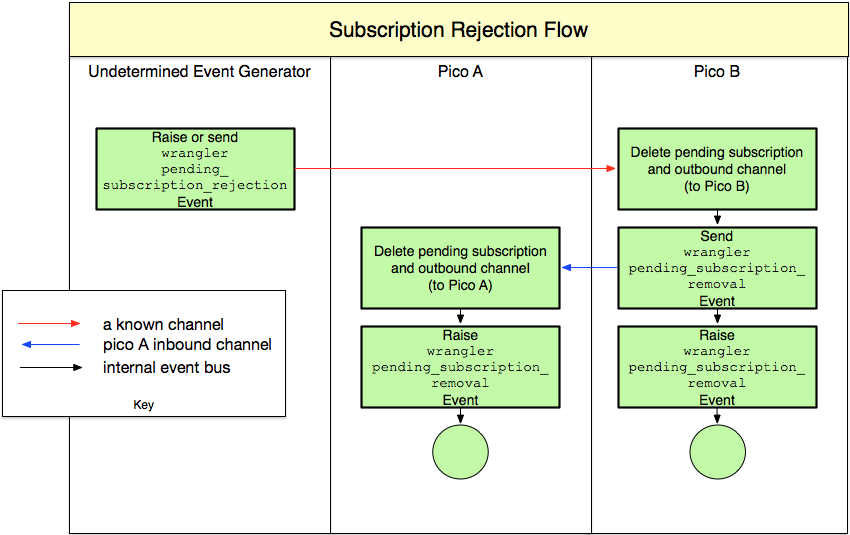Introduction to Subscriptions
Subscriptions allow two picos to communicate with each other on a secure channel. Subscriptions have several advantages and uses:
- Subscriptions can occur between any two picos, augmenting the parent-child hierarchy to create peer-to-peer structures.
- Subscriptions allow picos to establish communication channels with relationships.
Subscriptions are formed from two channels from two different Picos. Each channel has a corresponding Eci stored for the other Picos channel.
From each pico's perspective there is an incoming channel and an outgoing channel. The pico receives events and queries from the other pico in the subscriptions over the incoming channel and makes queries and sends events to the other pico using the outgoing channel.
Subscriptions can exist between any two picos. They do not have to have the same parent. In the Forever application, for example, the picos belonged to different people and represented their personal contact information.
There are several important steps in establishing a subscription:
- Pico A receives a
wrangler:subscriptionevent that includes the following attributes:name- name of subscription (if none is supplied, a random subscription name will be generated)name_space- name space for subscription (if none is suppliedsharedwill be used as the name space)my_role- Pico A's role in the subscription (if none is supplied,peerwill be used for the role)subscriber_role- Pico B's role in the subscription (also defaults topeer).subscriber_eci- Pico B's well known ECI. Pico A must receive an ECI to contact Pico B. (This eci will be stored after subscription has been accepted. only outbound eci should be used to raise events too.)channel_type- the channel type for Pico A's yet to be created inbound ECI (if none is supplied,subswill be used).attributes- the attributes for this subscription. These are used for Pico A's incoming channel's attributes.
- Pico A sends a
wrangler:pending_subscriptionevent to Pico B, using the channel given by thesubscriber_eci in step one with the following attributes:name- name of subscription.name_space- name space for subscription.my_role- Pico B's role in the subscription.subscriber_role- Pico A's role in the subscription.- outbound_eci - Pico A's newly created inbound ECI. Pico B must receive an ECI to contact Pico A.
channel_type- the channel type for Pico B's yet to be created inbound ECI.attributes- the attributes for this subscription. These are used for Pico B's incoming channel's attributes.
Pico A also raises an internalwrangler:pending_subscriptionevent with the corresponding attributes above. - Upon receiving the
wrangler:pending_subscriptionevent, Pico B, creates a pending subscription(channel mentioned above) and raises thewrangler:inbound_pending_subscription_event_addedinternal event. Pico A raises wrangler:outbound_pending_subscription_event_added internal event.
The state of each Picos subscription is static at this point. Pico A has on out going pending subscription and Pico B has an in coming pending subscription. - If Pico B wants to approve the subscription request, it raises the
wrangler:pending_subscription_approvalevent (internally) with an attribute namedchannel_namegiving the name of the channel to approve. Upon successfully creating the subscription. Pico B:- sends the
wrangler:pending_subscription_approvedevent to Pico A on Picos B outbound_eci. - raises the
wrangler:subscription_addedevent
- sends the
- Upon receiving the
wrangler:pending_subscription_approvedevent, Pico A adds an outbound_eci to the subscription on its side and raises thewrangler:subscription_addedinternal event. - If Pico B wants to reject the subscription, it raises the
wrangler:inbound_subscription_rejectionevent (internally) with an attribute namedchannel_name- the name of the channel to reject. Pico B:- sends the
wrangler:subscription_removalevent to Pico A on Picos B outbound_eci. - raises the
wrangler:subscription_removalevent.
- sends the
Upon receiving a wrangler:subscription_removal event, the pico deletes the named subscription from the inbound or outbound subscriptions list as appropriate.
Initial Subscription Flow
Subscription Approval Flow
Subscription Rejection Flow
Subscriptions Functions
Function | Use |
|---|---|
| subscriptions | List a set of subscriptions depending on what parameters are past. |
| subscriptionAttributes | Lists a subscriptions attributes |
| checkSubscriptionName | Checks if a subscriptions name exists |
All subscriptions functions return an object with a status and an return object except for checkSubscriptionName. Documentation will reference the return object only.
Subscriptions Actions
Event Domain | Event Type | Actions | Use |
|---|---|---|---|
| wrangler | subscription | creates outbound pending subscription and sends pending_subscription event to external pico | Creates a new outbound pending subscription |
| wrangler | pending_subscription | creates inbound pending subscription | Creates a new inbound pending subscription |
| wrangler | pending_subscription_approval | sends pending_subscription_approved event with inbound_eci and outbound status to external pico and raises pending_subscription_approved with inbound status | Aprove inbound pending subscription |
| wrangler | pending_subscription_approved | updates subscription status and outbound_eci if needed | Internally for adding aproved subscriptions |
| wrangler | subscription_cancellation | inbound_subscription_rejection | outbound_subscription_cancellation | sends subscription_removal event with eci and status and raise the same event to self | alert external pico to remove subscriptions and alert self to remove subscription |
| wrangler | subscription_removal | deletes channel used for subscription | internally for removing channel used for subscription |
subscriptions
returns an array of subscriptions collections keyed to subscriptions. Each subscriptions is owned by the pico which calls this function.
Parameter | Datatype | Required |
|---|---|---|
| <id> | <string> |
|
| <collection> | <string> | |
| <filtered> | <string> |
- <id> = <subscription channel_name> | <subscriptions channel_eci> | <subscriptions_name>
- <collection> = <name_space> | <relationship> | <status> | <channel_name> | <inbound_eci> | <outbound_eci> | <subscriber_role> | <my_role> | <subscriber_eci>(might break things) |<attributes>
- <filtered> = <desired value of collection>
On success
key | value |
|---|---|
subscriptions | [{<name_space:channel_name>: {"name_space":<string>,"relationship":<string>, "status":<string>, "channel_name":<string>, "inbound_eci":<string>, "subscriber_role":<string>, "my_role":<string>, "subscriber_eci":<string>, "attributes":<string>, "subscription_name":<string> }, },..{}n ] |
response = v1_wrangler:subscriptions(null,null,null){"subscriptions"}; // all subscriptions
response = v1_wrangler:subscriptions("flipper",null,null){"subscriptions"}; // single "flipper" subscriptions
response = v1_wrangler:subscriptions(null,"status",null){"subscriptions"}; // collection of subscriptions by status
response = v1_wrangler:subscriptions(null,"status","inbound"){"subscriptions"}; // collection of subscriptions with "inbound" as status



